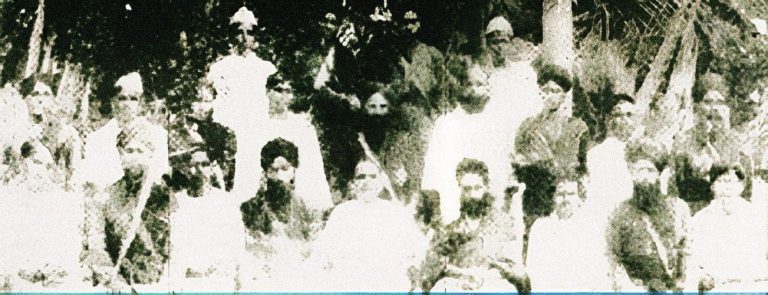
An overview into how the Vaikom Satyagraha, an anti-caste protest for access to mandirs, helped create a community of native Sikh converts in Kerala.
RATTAN SINGH (SIRPENTAPOTAMIA)
The Vaikom Satyagraha was a protest for access to the Sri Vaikom Mahadev Mandir by lower caste peoples, mostly Ezhavas in 1924. Lower caste individuals were also forbidden walking on any of the roads leading up to the mandirs. At the time, the town of Vaikom was administrated under the princely state of Travancore, which infamously had a rigid caste system in place.
Amongst the lower caste peoples of Kerala, Ezhavas comprised the clear majority alongside the Channans, Cherumas, Pulayas and Parayas. Even though, the caste system in Kerala had historically been rigid, even to the extent of impacting the life of Syriac Christians, reformers began to spring up such as Sri Narayana Guru, promoting social equality.
As a public agitation, the Vaikom Satyagraha gained support from various different communities. Congress leaders like Rajagopalachari and Periyar would later join and give aid to the activists, seeing it as an anti-colonial protest paving the way for Indian independence; akin to their support for the Akali movement. It was resolved towards the end of 1925 and the mandir roads were made public.
The Akalis at Vaikom
Christians, Muslims, Buddhists and Aryasamajists were among the groups interested in the socio-political ramifications of the Vaikom Satyagraha and all sought to extend their influence for proselytization. Similarly, an Akali jatha travelled from Punjab to Vaikom to establish a langar.
Lower caste individuals were also forbidden walking on any of the roads leading up to the mandirs.
The Akali jatha was led by Lal Singh and Kirpal Singh but was stopped by Mahatma Gandhi. He believed the Vaikom Satyagraha should rely less on outsiders and be led by the local volunteers instead. After this, the Akali jatha was often looked at with distrust and were denounced by the local press. Mahatma Gandhi felt similarly about other proselytizing groups such as the Christians and also rebuked them publicly because he believed the orthodox Hindus may see it as other religions disrupting order for the intent of conversion rather than it being led organically by lower caste peoples.
The Sikhs of Kerala
Shortly after, the SGPC sent a delegation of Sikhs to Kerala and a group of Ezhavas came to Amritsar to learn more about Sikhi. In 1936, the SGPC’s Sarb Hind Mission was inaugurated, where Sikh missionaries were sent to all parts of India, including Uttar Pradesh, Madhya Pradesh, Maharashtra and Kerala. Under this mission, Master Tara Singh and Sardar Lal Singh visited Kerala and constructed a few gurudwaras in Malabar.
On the Vaisakhi of 1936, some 300 families converted to Sikhi. An Ezhava leader, KC Kuttan, became Sardar Jaya Singh and his associates also became Sikh. On the 15th of June 1936, a ceremony took place at Sardar Jaya Singh’s house where 25 people converted to Sikhi. These Sikhs later opened coir factories for the benefit of new converts who were often shunned from society.
In November 1936, the Maharaja of Travancore issued a proclamation that all roads and schools would be for public use, irrespective of caste.
The Sarb Hind Mission had an office in Ernakulam and Ranni in Kerala. They also gained many followers in Maravanthuruthu, Karappuram and Muhamma. Newspapers reported that up to 800 people had converted to Sikhi in Kerala.
In November 1936, the Maharaja of Travancore issued a proclamation that all roads and schools would be for public use, irrespective of caste. This caused many of the Sikh converts to revert back to Hinduism.
Aftermath and influence

Of the aforementioned converts, only a few converts would remain Sikh after. A few converts like Bhuvender Singh, Kirpal Singh and Renjith Singh would start Kerala Sikh Mission and begin missionary work.
Singukandam was a village named after a Ezhava convert from Kerala, named Teja Singh, formerly Ramankutty. He moved to Punjab in the 1920s and later moved back Kerala in the 1930s. He set a company named ‘Guru Ramdas Works’, which functioned as a coir factory. The economic impact of WW2 would ruin the company and so he would live out his days as a cultivator in Singukandam. However, landlords would prevent him to do so and burn his house down alongside his saroop of the Sri Guru Granth Sahib.
During 1984, Kirpal Singh was captured by college students but was saved thusly after and sent to his home under full police protection. However, these incidents affected his son’s religiosity, leading him to becoming irreligious. Similarly, others in the community did the same, leading to less religious Sikhs in Kerala.
As of now, there are a few Ezhava Sikh elders alongside a community of Punjabi Sikhs living in Kerala. There are currently functioning gurudwaras in Kochi, Kannur and Thiruvananthapuram.
Read: Hindus, Sikhs build mosques for Muslim villagers in Indian Punjab
_________________
Courtesy: The Khalsa Chronicle (Published on May 27, 2024) Received by e-mail